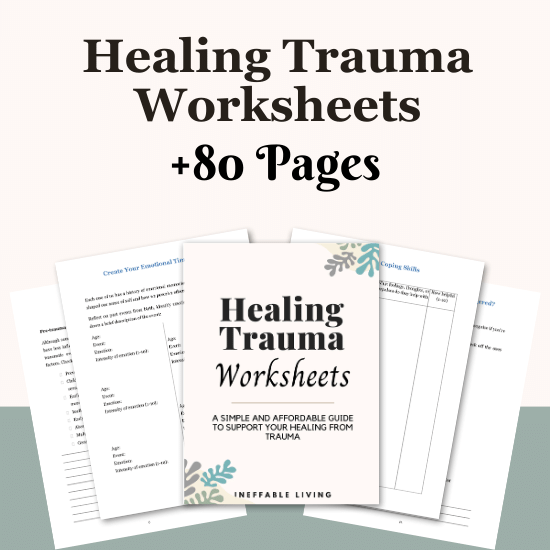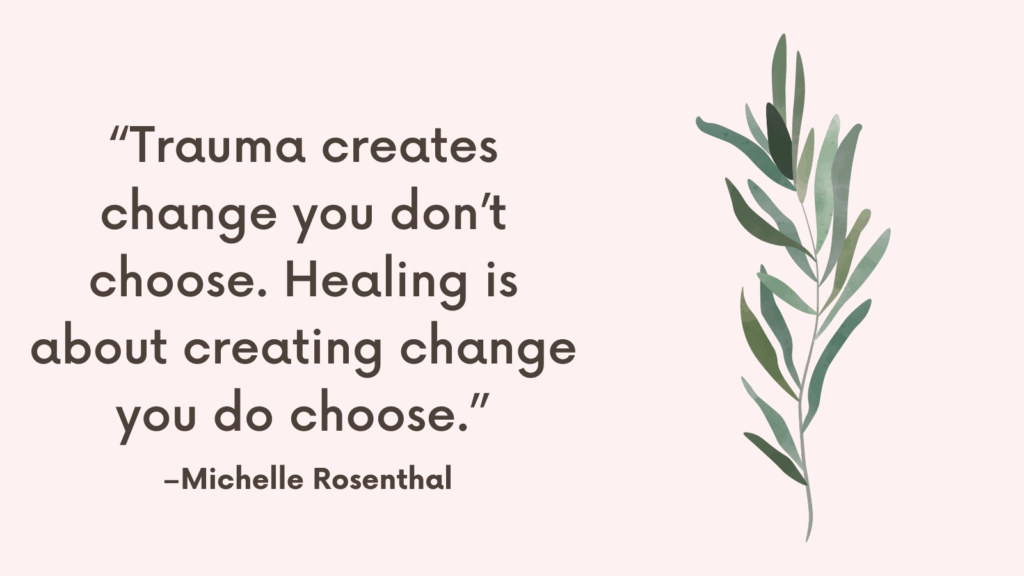In this post, you’re going to learn all about big T trauma – its signs and ways to heal.
Big T Trauma
Big T Trauma refers to an experience or event that is highly distressing, threatening or life-altering and can cause long-term psychological effects such as post-traumatic stress disorder (PTSD), depression, anxiety and other mental health issues.
What’s traumatic to one person may not be traumatic to another.
However, common examples of traumatic events include:
- Being a combat soldier
- Being exposed to war
- Being in a plane crash
- Being in a serious automobile accident
- Being seriously emotionally abused as a child
- Experiencing life-threatening neglect as a child
- Experiencing physical violence and/or sexual abuse as a child
- Having a murder in your family
- Surviving a fire
- Surviving a natural disaster (hurricane, tornado)
- Surviving a robbery or burglary
- Surviving an assault
- Surviving cult abuse
- Witnessing a natural but unexpected death
- Witnessing a violent death
- Working in a profession that exposes you to death, injury, or pain
Related: Why Is Trauma Therapy So Hard? (+Best Trauma Healing Exercises To Support Your Recovery)
Do I Have Trauma?
Some of the most common symptoms of trauma may include the following:
Cognitive symptoms
- Intrusive thoughts of the event
- Nightmares
- Flashbacks and Visual images of the event
- Forgetfulness and difficulty concentrating
- Disorientation
- Confusion
Behavioral symptoms
- Avoidance of activities or places that trigger memories of the event
- Social isolation and withdrawal
- Lack of interest in previously-enjoyable activities
Physical symptoms
- Changes in sleeping and eating patterns
- Chronic muscle pain
- Heightened startle response
- Edginess
- Hypervigilance: on the lookout for warnings of potential danger
- Sexual dysfunction
- Fatigue and exhaustion
Psychological symptoms
- Anger and irritability
- Anxiety
- Depression
- Detachment from other people
- Feeling numb
- Shock and disbelief
- Guilt
- Shame
- Overwhelming fear
- Panic attacks
- Mood swings
Related: 7 Trauma Release Exercises To Support Your Recovery After Trauma
When Trauma Becomes A Diagnosis
Most people who experience traumatic events may experience temporary distress, but with time and self-care, they get better.
For some people, symptoms of trauma get worse and may last for months and even year, interfering with their daily functioning. If that’s you may have PTSD.
Related: Best 10 Proven Ways to Heal From Childhood Trauma Splitting
What Is PTSD?
Post-traumatic stress disorder (PTSD) is a mental health condition that’s triggered by a traumatic event.
PTSD symptoms are generally grouped into four types:
- intrusive memories,
- avoidance,
- negative changes in thinking and mood, and
- changes in physical and emotional reactions.
Related: How to Practice Self-Brainspotting Safely?
DSM-5 Diagnostic Criteria for PTSD
Note: The following criteria apply to adults, adolescents, and children older than 6 years. For children 6 years and younger, see the DSM-5 section titled “Posttraumatic Stress Disorder for Children 6 Years and Younger” (APA, 2013a).
A. Exposure to actual or threatened death, serious injury, or sexual violence in one (or more) of the following ways:
- Directly experiencing the traumatic event(s).
- Witnessing, in person, the event(s) as it occurred to others.
- Learning that the traumatic event(s) occurred to a close family member or close friend. In cases of actual or threatened death of a family member or friend, the event(s) must have been violent or accidental.
- Experiencing repeated or extreme exposure to aversive details of the traumatic event(s) (e.g., first responders collecting human remains; police officers repeatedly exposed to details of child abuse). Note: Criterion A4 does not apply to exposure through electronic media, television, movies, or pictures, unless this exposure is work related.
B. Presence of one (or more) of the following intrusion symptoms associated with the traumatic event(s), beginning after the traumatic event(s) occurred:
- Recurrent, involuntary, and intrusive distressing memories of the traumatic event(s). Note: In children older than 6 years, repetitive play may occur in which themes or aspects of the traumatic event(s) are expressed.
- Recurrent distressing dreams in which the content and/or affect of the dream are related to the traumatic event(s). Note: In children, there may be frightening dreams without recognizable content.
- Dissociative reactions (e.g., flashbacks) in which the individual feels or acts as if the traumatic event(s) were recurring. (Such reactions may occur on a continuum, with the most extreme expression being a complete loss of awareness of present surroundings.) Note: In children, trauma-specific reenactment may occur in play.
- Intense or prolonged psychological distress at exposure to internal or external cues that symbolize or resemble an aspect of the traumatic event(s).
- Marked physiological reactions to internal or external cues that symbolize or resemble an aspect of the traumatic event(s).
C. Persistent avoidance of stimuli associated with the traumatic event(s), beginning after the traumatic event(s) occurred, as evidenced by one or both of the following:
- Avoidance of or efforts to avoid distressing memories, thoughts, or feelings about or closely associated with the traumatic event(s).
- Avoidance of or efforts to avoid external reminders (people, places, conversations, activities, objects, situations) that arouse distressing memories, thoughts, or feelings about or closely associated with the traumatic event(s).
D. Negative alterations in cognitions and mood associated with the traumatic event(s), beginning or worsening after the traumatic event(s) occurred, as evidenced by two (or more) of the following:
- Inability to remember an important aspect of the traumatic event(s) (typically due to dissociative amnesia, and not to other factors such as head injury, alcohol, or drugs).
- Persistent and exaggerated negative beliefs or expectations about oneself, others, or the world (e.g., “I am bad,” “No one can be trusted,” “The world is completely dangerous,” “My whole nervous system is permanently ruined”).
- Persistent, distorted cognitions about the cause or consequences of the traumatic event(s) that lead the individual to blame himself/herself or others.
- Persistent negative emotional state (e.g., fear, horror, anger, guilt, or shame).
- Markedly diminished interest or participation in significant activities.
- Feelings of detachment or estrangement from others.
- Persistent inability to experience positive emotions (e.g., inability to experience happiness, satisfaction, or loving feelings).
E. Marked alterations in arousal and reactivity associated with the traumatic event(s), beginning or worsening after the traumatic event(s) occurred, as evidenced by two (or more) of the following:
- Irritable behavior and angry outbursts (with little or no provocation), typically expressed as verbal or physical aggression toward people or objects.
- Reckless or self-destructive behavior.
- Hypervigilance.
- Exaggerated startle response.
- Problems with concentration.
- Sleep disturbance (e.g., difficulty falling or staying asleep or restless sleep).
F. Duration of the disturbance (Criteria B, C, D and E) is more than 1 month.
G. The disturbance causes clinically significant distress or impairment in social, occupational, or other important areas of functioning.
H. The disturbance is not attributable to the physiological effects of a substance (e.g., medication, alcohol) or another medical condition.
Source: APA, 2013a, pp. 271–272.
Related: How to Heal From Childhood Trauma? 9 Scientifically Proven Trauma Therapy Approaches to Recover From Complex Trauma
4 Practical Exercises To Support Trauma Healing
Practical Exercise 1 — Name Your Trauma
Traumatic Events Inventory
Begin by listing the traumatic events you experienced in your life. The following is a list of events that can be traumatic:
- Witnessing a natural but unexpected death
- Witnessing a violent death
- Having a murder in your family
- Surviving a robbery or burglary
- Surviving an assault
- Experiencing physical violence and/or sexual abuse as a child
- Experiencing life-threatening neglect as a child
- Being seriously emotionally abused as a child
- Surviving cult abuse
- Surviving a natural disaster (hurricane, tornado)
- Surviving a fire
- Being in a serious automobile accident
- Being in a plane crash
- Being exposed to war
- Being a combat soldier
- Working in a profession that exposes you to death, injury, or pain
Reflect back on the traumatic experience(s) that triggered the development of PTSD.
If you are still unable to pinpoint the traumatic event, take the event that haunts you the most.
Take your journal and write everything you recall about this event. It’s fine if you can’t remember certain aspects of your trauma. Don’t fill in any of the blanks in your memory.
Related: Inner Child Wounds Test (+4 Attachment Imagery Exercises To Heal Inner Child Wounds)
Practical Exercise 2 — Identify Your Symptoms
You might have been suppressing and avoiding your symptoms of PTSD like avoiding triggers and numbing your anxiety.
Become more mindful of these symptoms you’re experiencing and write them down in journal.
To identify your symptoms ask yourself which of the symptoms listed above can you relate to most? And of these symptoms, which are most distressing to you?
Practical Exercise 3 — Get More Support
Identify available factors that can support your healing and help you feel normal and less alone.
Make a plan and start practicing these activities.
Find a support group in your community. Avoid support groups that focus on the details of trauma and instead find one that focuses on healing and recovery.
Related: Healing From Emotional Abuse In 12 Practical Steps
Practical Exercise 4 — Change Your Physiology
When the stress response is unnecessarily activated by a perceived danger, calm yourself down using the following techniques:
1. Mammalian Dive Reflex
The diving reflex is the body’s physiological response to submersion in cold water. It causes immediate decrease in heart rate and metabolism, which helps you calm down faster.
* Submerge your face in cool water (below 21 degrees Celsius or 70 degrees Fahrenheit) for thirty seconds.
* Making sure your forehead, temples, and ears are under water.
Consult your doctor before doing this exercise if you have a medical condition
2. Deep Breathing
Take gigantic deep breaths, followed by a short period of not breathing.
* After exhaling, simply stop breathing for as long as it feels comfortable.
* Repeat until you feel calmer
3. Other Techniques to Calm Yourself Down
* Do five minutes of intense physical activity, like push-ups, jumping jacks, etc. while at the same time saying out loud, “I am completely safe,” over and over again.
* Do a Sudoku puzzle or solve a few math problems to activate the rational part of your brain and to deactivate the emotional part.

Conclusion
Trauma is part of many people’s lives at some point.
Millions of people around the world are affected by PTSD.
Worldwide pandemics, terrorist attacks, natural disasters, wars, motor-vehicle accidents, bullying, workplace harassment, relationship and child abuse (mental, emotional, physical, and sexual), and other events anyone would consider traumatic and extremely stressful, might cause PTSD (Post-Traumatic Stress Disorder)
You might not even understand why you’re unable to “get over it”, and assume that you’re exaggerating or being “overly sensitive.”
The truth is, PTSD causes real, measurable changes to areas of the brain responsible for mediating stress, emotion, memory, and other cognitive and physiological functions.
But these changes aren’t permanent and you can recover from PTSD.
References
- Portions of this article were adapted from the book Diagnostic and Statistical Manual of Mental Disorders, Fifth Edition, Text Revision (DSM-5-TR), © 2021 by the American Psychiatric Association. All rights reserved.
- Understanding the Impact of Trauma – Trauma-Informed Care in Behavioral Health Services – NCBI Bookshelf (nih.gov)
- Trauma | Psychology Today
- Treating PTSD: A Review of Evidence-Based Psychotherapy Interventions – PMC (nih.gov)
- Treatments for PTSD (apa.org)
- Unlocking PTSD: New study reveals why trauma-focused psychotherapy treatment works — ScienceDaily



